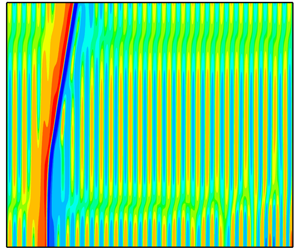Article contents
Receptivity of inviscid modes in supersonic boundary layers due to scattering of free-stream sound by localised wall roughness
Published online by Cambridge University Press: 04 June 2020
Abstract

The present paper investigates the receptivity of inviscid first and second modes in super/hypersonic boundary layers due to the interaction between a weak free-stream acoustic wave and a small isolated surface roughness element. The large-Reynolds-number asymptotic analysis reveals the detailed processes of the excitation. The distortion of the acoustic signature by the curved wall contributes to the leading-order receptivity, producing an eigenmode of  $O({\mathcal{E}}h)$ amplitude, where
$O({\mathcal{E}}h)$ amplitude, where  ${\mathcal{E}}\ll 1$ is the magnitude of the acoustic wave and
${\mathcal{E}}\ll 1$ is the magnitude of the acoustic wave and  $h\ll 1$ the roughness height normalised by the local boundary-layer thickness
$h\ll 1$ the roughness height normalised by the local boundary-layer thickness  $\unicode[STIX]{x1D6FF}$. The interactions between the roughness-induced mean-flow distortion and the acoustic signature contribute to the second-order receptivity, which is of
$\unicode[STIX]{x1D6FF}$. The interactions between the roughness-induced mean-flow distortion and the acoustic signature contribute to the second-order receptivity, which is of  $O({\mathcal{E}}hR^{-1/3})$ with
$O({\mathcal{E}}hR^{-1/3})$ with  $R\gg 1$ being the Reynolds number based on
$R\gg 1$ being the Reynolds number based on  $\unicode[STIX]{x1D6FF}$. Interestingly, the leading-order receptivity is equivalent to a canonic receptivity problem, the excitation by time-periodic blowing and suction through a local slot on the wall, and the effective periodic outflux velocity forced from the underneath Stokes layer can be determined explicitly in terms of the roughness shape function. This equivalence holds when
$\unicode[STIX]{x1D6FF}$. Interestingly, the leading-order receptivity is equivalent to a canonic receptivity problem, the excitation by time-periodic blowing and suction through a local slot on the wall, and the effective periodic outflux velocity forced from the underneath Stokes layer can be determined explicitly in terms of the roughness shape function. This equivalence holds when  $h=O(R^{-1/3})$, for which the roughness-induced mean-flow distortion becomes nonlinear. A systematic parametric study is carried out for the excitation of the first and second modes by both fast and slow free-stream acoustic waves, and the dependence of the receptivity efficiency on the relevant parameters is provided. Interestingly, the second-order receptivity could become dominant (e.g. in the case of slow acoustic waves with low frequencies and small incident angles), but the present mathematical theory remains valid. In order to check the accuracy of the asymptotic predictions, we have carried out direct numerical simulations (DNS) and also extended the existing finite-Reynolds-number theory to the supersonic regime. The asymptotic solutions agree with the results given by the finite-Reynolds-number calculations and DNS when
$h=O(R^{-1/3})$, for which the roughness-induced mean-flow distortion becomes nonlinear. A systematic parametric study is carried out for the excitation of the first and second modes by both fast and slow free-stream acoustic waves, and the dependence of the receptivity efficiency on the relevant parameters is provided. Interestingly, the second-order receptivity could become dominant (e.g. in the case of slow acoustic waves with low frequencies and small incident angles), but the present mathematical theory remains valid. In order to check the accuracy of the asymptotic predictions, we have carried out direct numerical simulations (DNS) and also extended the existing finite-Reynolds-number theory to the supersonic regime. The asymptotic solutions agree with the results given by the finite-Reynolds-number calculations and DNS when  $R$ is sufficiently large (typically
$R$ is sufficiently large (typically  $R=O(10^{5})$). An improved large-Reynolds-number approach is developed by replacing the non-penetration boundary condition by an unsteady outflux, which accounts for the
$R=O(10^{5})$). An improved large-Reynolds-number approach is developed by replacing the non-penetration boundary condition by an unsteady outflux, which accounts for the  $O(R^{-1/2})$ viscous correction by the Stokes layer. With this modification, the accuracy of the receptivity calculation at moderate Reynolds numbers (approximately a few thousands) is improved remarkably.
$O(R^{-1/2})$ viscous correction by the Stokes layer. With this modification, the accuracy of the receptivity calculation at moderate Reynolds numbers (approximately a few thousands) is improved remarkably.
- Type
- JFM Papers
- Information
- Copyright
- © The Author(s), 2020. Published by Cambridge University Press
References
- 34
- Cited by


